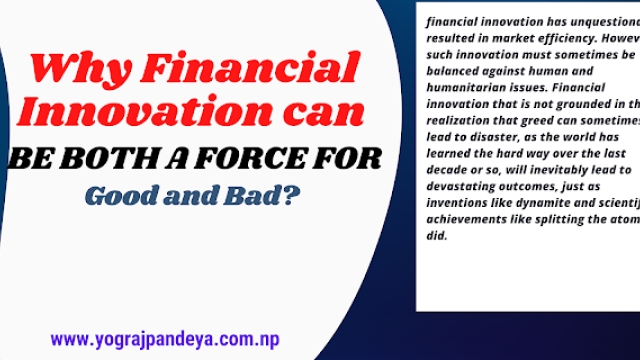Why Financial Innovation can be both a Force for Good and Bad?
Exotic Innovations or Weapons of Mass Destruction?
Exotic financial products such as Derivates, Swaps, Credit Default Swaps, and Options have played a devastating part in the severe and protracted financial crises of the previous eight years, as everyone who has followed them closely knows. These products, which were meant to be used to mitigate risk, have instead grown so poisonous to the global financial system and economy that Warren Buffett, the famed American investor, dubbed them “Financial Weapons of Mass Destruction.”
This is because the financial inventive instruments that were heralded as delivering a degree of stability and risk hedge when they were originally established actually turned into liabilities since, as it turned out, they weren’t very effective at pricing risk and hedging against defaults.
What is FinancialInnovation and Why it was Welcomed?
Before going any further, it’s important to grasp what Financial Innovation entails. Financial instruments are often designed to price, risk factors, and hedge against hazards such as counterparty default, as management students learn during their MBAs and other courses. Furthermore, financial innovations are a result of the very real risk that financial and physical assets may lose value unexpectedly owing to economic cycles, while also inflating beyond measure, resulting in wild gyrations in the financial markets.
As a result, derivatives, which get their name from the fact that they “derive” their value from underlying assets, are designed to safeguard both purchasers and sellers of such assets against excessive volatility and extreme price swings.
When is Financial Innovation Bad?
So, what exactly is the problem if the risk is priced in and credit events like defaults are hedged against?
Part of the solution is that innovation is beneficial as long as it is directed and regulated consistently. When an invention takes on a life of its own, the net consequence, or end result, is that neither the inventors nor the users of the innovation are sure what they’re talking about.
Of course, this does not imply that innovation is essentially evil, or that financial innovation is inherently bad. Indeed, Customers, particularly retail consumers like you and me, have only had increased control over our savings, portfolios, and assets as a result of financial advancements in the previous several decades.
How can we use Financial Innovation for Good?
It is only as a result of financial innovations in the last few decades that consumers, particularly retail consumers like you and me, have been able to exert greater control over our finances. Thus, while we do not advocate that financial innovation cease, we do advocate for financial innovation that benefits society and does not become overly complicated and complex to the point where only a few financial experts understand what it is all about. Indeed, there are countless examples of financial innovation that are carried out to really improve the lives of the poor rather than just for the sake of profit.
These include the Microcredit Initiative, which was pioneered by Nobel Laureate and Social Entrepreneur Mohammed Yunus of Bangladesh, who with his Grameen Bank was able to bring banking to poor women who had previously been denied access to structured credit and were at the mercy of unscrupulous money lenders.
Alternatively, banks like Bandhan in the Eastern Indian state of Bengal are leading a revolution in banking for the poor. Of course, even in the West, there are numerous examples, such as the Commodity Bourses, which have aided farmers in hedging against bad harvests, weather changes, and even pure speculation that can result in price volatility as a result of bankers combining the financial profit imperative with that of social responsibility.
Profits are not the Only Criteria
As a result, it can be claimed that, like everything else in the world of business and finance, financial innovation must be embraced and even supported and promoted at all costs if it has the underlying goal of really uniting profitability with social transformation. However, when financial innovation becomes just another kind of speculation with the only goal of making as much money as possible, it is something that we must be concerned about.
The Emerging Threats of High-Speed Trading with Uber Complex Financial Instruments
Furthermore, with the advent of high-speed trading and electronic trading, it is undeniable that the marriage of advanced technology with overly complex financial products is leading us to a dangerous situation in which the speed of technological change and the increase in complexity results in a high-stakes game of cards in which the decisions are made not by humans but by machines, which, while ostensibly objective, can veer out of control. Indeed, the fact that computers have taken over the functions that traders used to play in the markets implies that there’s a good likelihood that there won’t be many specialists left who understand what’s going on in the future.
Conclusion
To summarize, financial innovation has unquestionably resulted in market efficiency. However, such innovation must sometimes be balanced against human and humanitarian issues. Financial innovation that is not grounded in the realization that greed can sometimes lead to disaster, as the world has learned the hard way over the last decade or so, will inevitably lead to devastating outcomes, just as inventions like dynamite and scientific achievements like splitting the atom did.
More:
- 1. Role of the Finance Function in the Financial Management for Corporates
- 2. Financial Intermediaries – Meaning, Role, and Its Importance
- 3. 7 Modern Financial Management Techniques that Will Change Your Business
- 4. Profit Maximization Criticisms
- 5. Financial Goal – Profit vs Wealth
- 6. Capitalization in Finance
- 7. Capital Structure – Meaning and Factors Determining Capital Structure
- 8. Role of a Financial Manager
- 9. The Role of the Finance Function in Organizational Processes
- 10. Finance Functions
- 11. Financial Planning – Definition, Objectives, and Importance
- 12. Financial Management – Meaning, Objectives, and Functions


